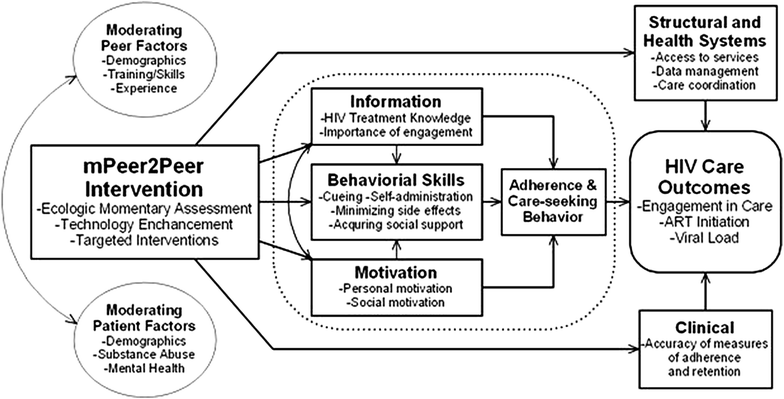Acceptability of a mobile health intervention to enhance HIV care coordination for patients with substance use disorders
- PMID: 28441962
- PMCID: PMC5405459
- DOI: 10.1186/s13722-017-0076-y
Acceptability of a mobile health intervention to enhance HIV care coordination for patients with substance use disorders
Abstract
Background: Persons living with HIV and substance use disorders face barriers to sustained engagement in medical care, leading to suboptimal antiretroviral treatment outcomes. Innovative mobile technology tools such as customizable smartphone applications have the potential to enhance existing care coordination programs, but have not been rigorously studied.
Methods: We developed and implemented a two-component intervention consisting of peer health navigation supported by a smartphone application conducting ecologic momentary assessment (EMA) of barriers to care and medication adherence. Patients with a history of antiretroviral treatment failure and substance use were recruited to participate in the 9-month pilot intervention. Three peer health navigators were trained to provide social and logistical support while participants re-engaged in HIV care. We assessed the acceptability of the intervention components using qualitative analysis of in-depth interviews conducted with study participants and peer navigators.
Results: Of 19 patients enrolled in the study, 17 participated for at least 2 months and 15 completed the entire 9-month study protocol. The acceptability of the peer navigation intervention was rated favorably by all participants interviewed, who felt that peer support was instrumental in helping them re-engage in HIV care. Participants also responded favorably to the smartphone application, but described its usefulness mostly as providing reminders to take medications and attend appointments, rather than as a facilitator of patient navigation.
Conclusions: Peer health navigation and smartphone-based EMA are acceptable approaches to facilitating engagement in HIV care for drug using populations. Future studies to evaluate the efficacy of this approach for improving long-term retention in care and antiretroviral treatment outcomes are warranted. ClinicalTrials.gov Identifier NCT01941108; registered on September 4, 2013.
Figures
References
-
- UNAIDS: UNAIDS fact sheet 2015. In Geneva: Joint United Nations Programme on HIV/AIDS (UNAIDS); http://www.unaids.org/sites/default/files/media_asset/20150901_FactSheet.... Archived at http://www.webcitation.org/6ehnTuiGs on 01/21/16; 2015.
-
- Bangsberg DR, Hecht FM, Charlebois ED, Zolopa AR, Holodniy M, Sheiner L, Bamberger JD, Chesney MA, Moss A. Adherence to protease inhibitors, HIV-1 viral load, and development of drug resistance in an indigent population. AIDS. 2000;14(4):357–366. doi: 10.1097/00002030-200003100-00008. - DOI - PubMed
-
- Huang YF, Kuo HS, Lew-Ting CY, Tian F, Yang CH, Tsai TI, Gange SJ, Nelson KE. Mortality among a cohort of drug users after their release from prison: an evaluation of the effectiveness of a harm reduction program in Taiwan. Addiction. 2011;106(8):1437–1445. doi: 10.1111/j.1360-0443.2011.03443.x. - DOI - PubMed
Publication types
MeSH terms
Substances
Associated data
Grants and funding
LinkOut - more resources
Full Text Sources
Other Literature Sources
Medical
Research Materials



